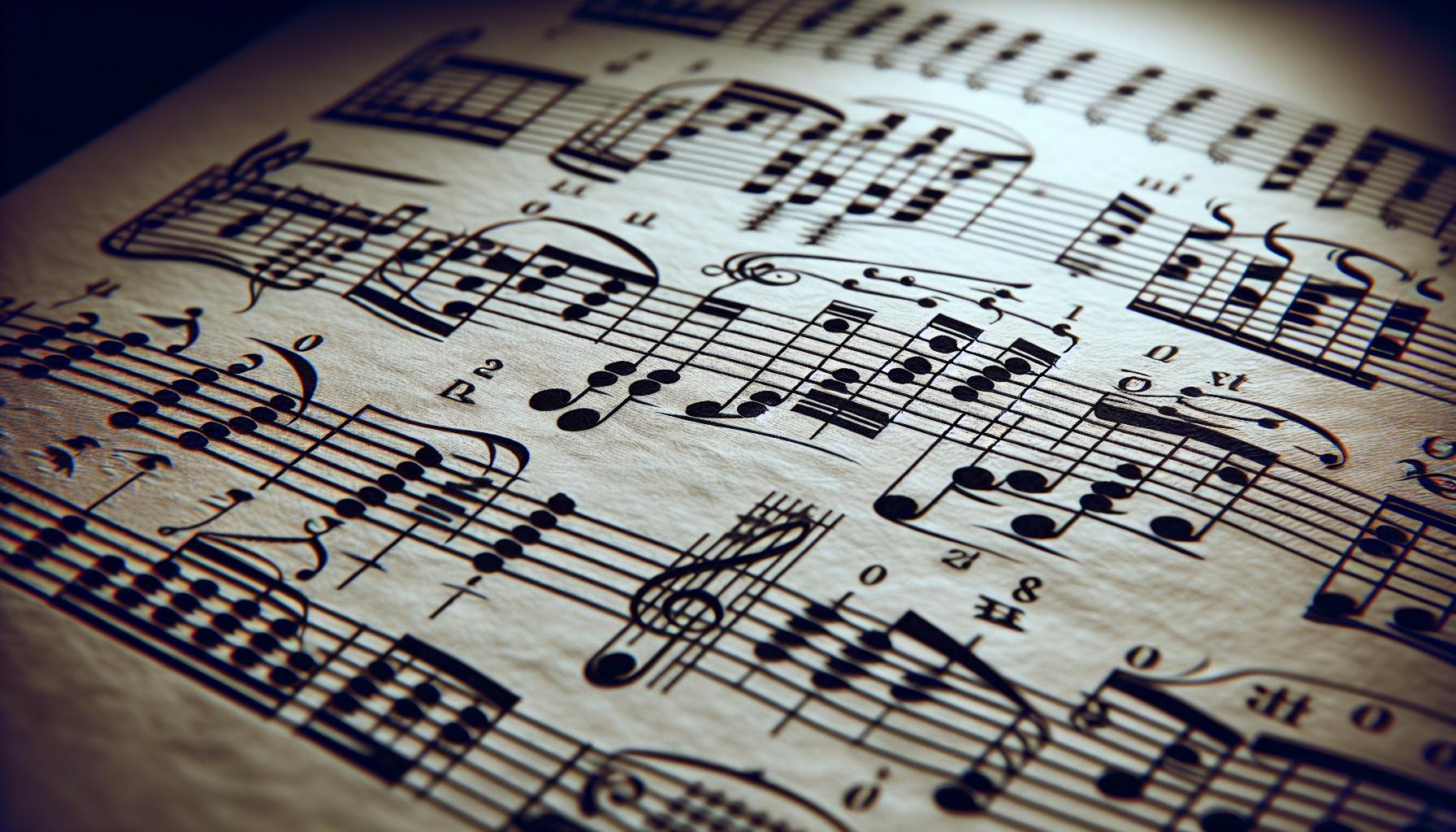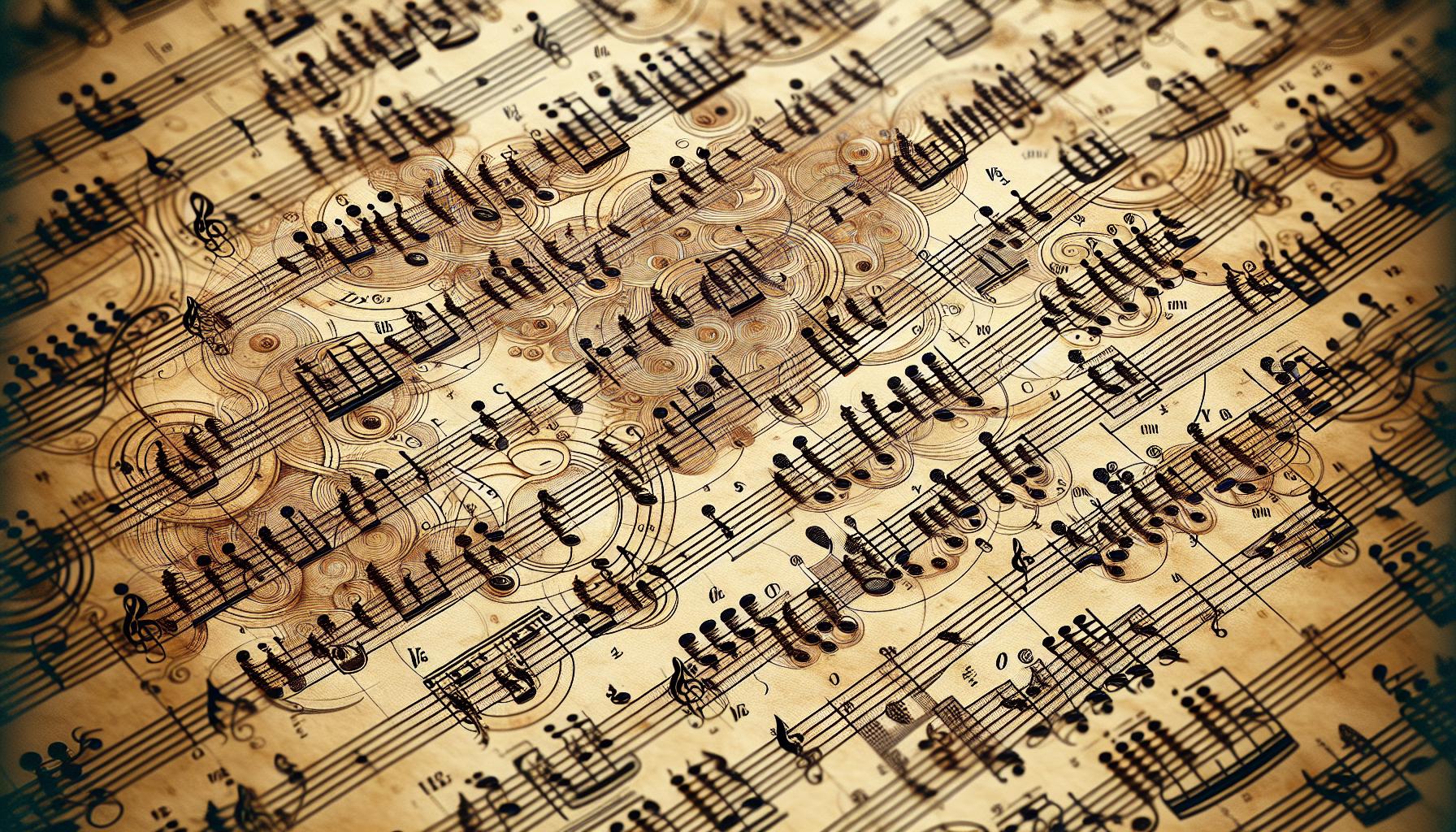If you’ve ever wondered how musicians can play such complex pieces, it’s all thanks to music notation. This system of symbols and marks is the language of music, allowing composers to transcribe their musical ideas and performers to interpret them.
Diving into music notation and sheet music might seem daunting at first. But don’t worry, I’m here to guide you through it. We’ll start with the basics, breaking down the elements that make up a piece of sheet music.
Contents
The Importance of Music Notation
Immerse yourself in the world of music and you’ll soon realize the critical role of music notation. It’s like a universal language, bridging gaps between composers, performers, and even musical eras. It’s not just about writing and reading music but about preserving, communicating and creating.
When a composer has an idea, they need a means to record it. Notes alone aren’t enough; they need to be described through rhythm, pitch, speed, and dynamics. That’s where music notation steps in, providing a detailed representation of the composer’s vision. Think of it as a detailed road map guiding performers on the journey the composer intended.
Aside from being a map for musicians, sheet music and notation serve as an archive, a record of musical history. Music from centuries back is still available to us thanks to the notation system. Imagine hearing a piece of music from the renaissance period; it’s akin to travelling back in time!
Moreover, diving into music notation improves musicianship and broadens opportunities. Understanding sheet music can open doors to orchestras, choral groups or jazz ensembles – all of which predominantly use written notation. It’s also a core aspect of music theory. So, learning to read notation is akin to learning the ABCs of music.
There’s also an element of consistency. One of the greatest advantages of music notation is the uniformity it propagates. No matter where a musician is located, the language of music notation remains the same. Be it Tokyo or Texas, a musical G is a G!
It’s clear that music notation lays the foundation of music comprehension and communication. If you want to communicate music in written form, craft detailed musical compositions, or even just understand music better – decoding the symbols and marks of music notation should be on your list.
What is Music Notation?

Let’s dive deeper and unravel this term – Music Notation. It’s the language in which the melody, rhythm, and harmony of music are written down using symbols. Typically, these symbols represent notes that are played on an instrument, such as a piano or guitar, or sung by a singer.
What you’re presumably picturing in your mind right now – those rows of lines (also known as staves) covered by black dots and signs – that’s exactly what we’re talking about. Music notation allows us to capture and document musical pieces in a form that can be universally understood.
Technically, if you’re thinking it’s merely a way of writing down sounds, you’ve got it partially right. But in a broader context, music notation is more than just a way of writing down sounds; it’s a trusted tool for musicians and composers to communicate musical information efficiently and effectively.
Music notation, furthermore, translates the artist’s auditory vision into a visual guide. This guide acts as the blueprint for the music’s performance, passing the creative baton from the composer to the performer, ensuring the ideas are conveyed as intended even across geographical boundaries and time periods.
When thinking about music notation, Sheet Music plays an integral role. Sheet music is the printed version of music notation, allowing a piece of music to be read and performed, keeping the original intentions of the composer intact. In other words, it is the ‘hard copy’ of a musical piece, just like a book is to a story. It’s an important source of historical archive too, preserving music from different eras.
The rhythm, melody, harmony, and dynamics – all key features of a musical piece – can be precisely fixed and relayed with notation and sheet music. Yet, it also leaves some room for the performer’s own interpretation and improvisation.
To sum up, musical notation is not merely a recording system; it packs in itself, the power of a universal language. Understanding and learning this language further enriches our musicianship and unlocks myriad musical possibilities- a fact I can’t stress enough.
The Elements of Sheet Music
As we delve deeper into the realm of sheet music, it’s integral to recognize the components that constitute it. Sheet music is a written representation of music, a universal language that musicians worldwide can interpret. Breaking down sheet music into its core components allows us to better understand and appreciate its key elements.
Firstly, we have the staff – a series of horizontal lines where our musical notes are written. It’s where the magic happens, where music comes alive. Standard sheet music uses a five-line staff, creating a framework that facilitates musical communication among artists.
Secondly, we find notes and rests. These symbols represent the music’s melody and rhythm, defining the length of the sound or the silence. They’re of varying types, indicating different lengths of musical sounds or rests, depending on the requirements of the composition.
Next is the clef, an important sign that lets us know which notes are represented on the staff. The most common clefs are the treble and bass, defining the high and low areas of the pitch spectrum, respectively.
Lastly, we should consider the key and time signatures. These signs offer necessary context. The key signature shows what major or minor key the piece is in, while the time signature indicates the rhythm. They’re crucial for understanding the structure and flow of the piece.
Understanding these fundamental elements of sheet music allows us to connect more deeply with a piece, creating a more profound and meaningful musical experience. In grasping the language of music, we immerse ourselves in a world of exquisite symphony and rhythm, leading to greater musical prowess and a true appreciation of the art. As we’ve discovered, music notation isn’t just about symbols or notes – it’s about understanding the lifeblood of music.
Understanding Key Signatures and Time Signatures
Let’s dive deeper into the nitty-gritty of music notation – Key Signatures and Time Signatures. Just like a map’s legend, they guide musicians, helping understand the structure and navigation of a piece.
When we talk about key signatures in music, we’re referring to the collection of every accidental (you may know them as sharps ‘#’, and flats ‘♭’) in a piece of music, represented at the beginning of each line. They tell us what key the music is in. Music can be in a major key, leading to an upbeat and happy sound, or a minor key, leading to a more serious or melancholic sound.
Here’s a brief table to help you understand some common key signatures:
| Key Signature | Major or Minor | Key |
|---|---|---|
| No flats or sharps | Major | C |
| 1 sharp | Major | G |
| 2 sharps | Major | D |
| 3 sharps | Major | A |
| 3 sharps | Minor | F# |
| 1 flat | Major | F |
| 2 flats | Major | B♭ |
| 3 flats | Major | E♭ |
| 3 flats | Minor | Cm |
| This list can go on but I find having these basics in mind can truly enhance the overall understanding of any sheet music you encounter. |
As for time signatures, they are essential music notation elements that control the rhythm of the piece. It’s notated at the beginning of every piece of music, right after the clef and the key signature. The top number denotes the number of beats per measure while the bottom number reveals what kind of note is counted as one beat.
| Time Signature | Beat Type |
|---|---|
| 2/2 | Half Note |
| 2/4 | Quarter Note |
| 3/4 | Quarter Note |
| 4/4 | Quarter Note |
| So, that’s how we decipher key signatures and time signatures. And let me tell you, these elements are much like the hidden treasure map of a song. Unravel them and you’re half-way through mastering any piece of music! |
Reading and Interpreting Sheet Music

Diving deeper into the world of music notation, reading and interpreting sheet music plays a significant role. It’s an essential skill for any musician regardless of their level of expertise. But know that it’s not just about identifying notes on the staff; there’s much more to it.
First off, it’s crucial to comprehend the various elements of a music sheet. You’ll encounter elements such as clefs, bars, and rests which all hold significant meaning. For instance, clefs assign individual notes to certain lines and spaces. Bars, on the other hand, divide the staff into manageable chunks. Moreover, not all space is filled with notes – silences or rests are equally integral to music.
Then comes your ability to interpret the key and time signatures. Remember, the key signature indicates what key the music is in – major or minor – and outlines the specific sharps or flats in a piece. This allows musicians to understand what scales they will predominantly use. Next, the time signature indicates the rhythm of the piece, laying out the number of beats per measure and the type of note that is counted as one beat. This influences the pulse and rhythm of the piece.
But, it doesn’t stop there. Dynamics also play a vital role. They indicate the volume of the piece – whether it’s to be played softly (piano) or loudly (forte).
Deciphering sheet music can seem daunting. But remember, practice makes perfect. Grasping these complex aspects is a challenge. However, it’s a skill that will put you on track to becoming a capable musician. Let’s keep digging deeper. Ahead, we’ll talk about different types of notes and rests, and their importance to understand rhythms and melodies in a more profound way.
Conclusion
We’ve journeyed through the world of music notation and sheet music, exploring its many facets. It’s clear that understanding these elements is crucial to becoming a proficient musician. From clefs to bars, rests to key signatures, every detail plays a significant role in reading and interpreting music. Sure, it might seem daunting at first, but with consistent practice, you’ll find yourself navigating through sheet music with ease. As we move forward, we’ll delve into the different types of notes and rests, deepening our understanding of rhythms and melodies. Remember, practice makes perfect, and in the world of music, that’s a melody to live by.
